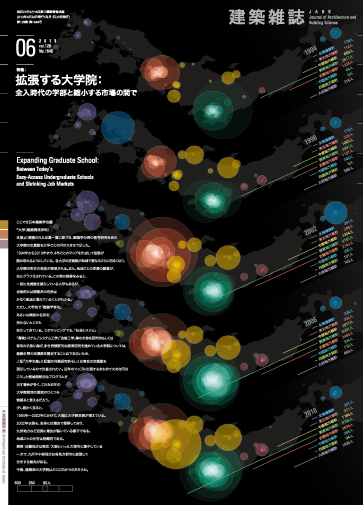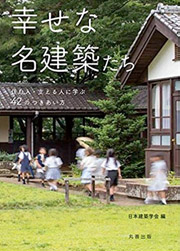本文PDFの閲覧につきましては、こちらでご確認ください。

2013-6月号 JUNE
特集= 拡張する大学院
─全入時代の学部と縮小する市場の間で
Expanding Graduate School─ Between Today’s Easy-Access Undergraduate Schools and Shrinking Job Markets
特集前言 拡張の底に、そして先に
本特集では、今日の建築教育の潮流をつかまえるために、大学院に注目することにした。
第1部は「認識」編であり、編集部によるデータと、本会建築教育委員会の石川孝重氏の寄稿とで、「建築教育が置かれている環境」を一瞥する。知られるとおり、日本では数年前から「全入時代」への突入が取沙汰されている。加えて、近年大学に送り込まれている学生たちは、いわゆる「ゆとり世代」に属す。学生の学力や学習意欲が低下してきたと嘆く大学教員は多い。他方で、文部科学省の指導強化、JABEE受審、建築士受験資格要件の審査厳格化といった動向がある。これら諸条件のなかで、学部教育は平準的な枠組みを固めていく傾向にあり、独自の教育内容を構想する自由は小さい、と言えるのではなかろうか。
他方で、グローバルな経済環境のなかで日本の社会経済システムは激変期を迎えており、学生の就職は量的にも質的にも多様化・ボーダレス化している。そもそも大学はありうべき社会再編を牽引するような「知」をさまざまな角度や射程で生み出す場所であったはずだが、今やすっかり官僚機構のごとくで、柔軟さも、芯の強ささえも失いかねないところまで来ている。
しかし、大学院にはまだ機動的な生産性がある。修士課程の2年間というサイクルの早さもプログラムの新陳代謝には都合がよいし、何より4 年間の基礎教育を終えた学生たちがいる。全入時代を迎えて平準化する学部と、縮小し激変していく市場との間に挟まれて、大学院の教育はさまざまな「外部」に接続しつつ先鋭化し、全体として拡張しつつあるのではないか。それらが来るべき新しい大学像につながる実験群となるのだろうし、またいずれ学部教育にも波及する可能性がある。
第2部「実践─先鋭化する大学院教育」では、過去10年ほどの間に生み出されてきた大学院教育のさまざまな実践例12を掛け合わせ、六つの対談で紹介していく。登場いただいたのは、北山恒・塚本由晴(建築設計教育におけるスタジオ制と研究室制)、岡部明子・馬場正尊(社会システムとフィールドワーク)、鵜飼修・久隆浩(まちづくりにおける地域参画)、金田充弘・三田彰(構造学におけるデザインと先端技術)、川瀬貴晴・小玉祐一郎(パッシブデザインと設備エンジニアリング)、小林正美・山代悟(教育の国際化とアーバンデザイン・ワークショップ)の諸氏である。
さて、よく考えてみるとこれらの動向は、1960-70年代に社会経済の激変に呼応しながら、あるいは体制への対抗的な価値軸として噴出した多様な思潮と実践に、すでにその前例があるようにも見える。ただ、当時の大学院生たちが生々しい都市・地域や海外の地に飛び出したのは、日本の大学(象牙の塔)への批判でもあったのに対し、今日では、大学こそが「外部」を必死に取り込もうとしている。
そこで第3部「歴史的参照─拡張と変貌の1960-70年代」では、今日の状況をいくらか歴史的に相対化することを意図した。松永安光氏にはアメリカのアーバンデザイン・スタジオ、元倉眞琴氏にはデザインサーヴェイ、趙海光氏には「私塾」としての高山建築学校について、また、尾島俊雄氏には環境工学という分野の成立経緯について執筆いただいた。
第4部は「外部からの検証─大学院には何が求められるか」と題して、大学・大学院で建築を学んだ若者の受入先となる社会の各分野から、率直な意見をいただくことにした。コメントを寄せていただいたのは、王方戟、梅咲直照、金箱温春、北村康、鈴木貴仁、田辺潔、谷尻誠、田根剛、中山高樹、七星岳也、西和彦、橋本純、藤澤一善、山田淳史、山梨知彦、山本和彦の16氏である。
本特集では、拡張していく建築教育の断面が描き出されている。それらの底に、あるいは先に、時代への適応以上のどんな思想を築くのか、それを問うきっかけとしていただければ幸いである。
会誌編集委員会
本号編集担当:生田京子(名城大学)・樫本信隆(日建設計)・砂本文彦(広島国際大学)・田村和夫(千葉工業大学)・渡邉浩文(東北工業大学)
[目次]
| 000 | 連載 再建への意志:図面のなかの都市復興 スマトラ沖地震のビレッジプラン/志摩憲寿 |
| 002 | 会長就任の挨拶 東日本大震災の経験を生かし、レジリエントで持続可能な社会に向け、総力を結集できる学会を目指して/吉野博 |
| 004 | 連載 東日本大震災|連続ルポ1|動き出す被災地 被災地3県の建設コスト/冨樫馨 |
| 006 | 連載 東日本大震災|連続ルポ2|仮すまいの姿 弱い絆の強さ─沖縄県における原発事故避難者レポート/高橋征仁 |
特集 拡張する大学院:全入時代の学部と縮小する市場の間で
| 008 | 特集前言 拡張の底に、そして先に |
第1部 認識─建築教育が置かれている環境
| 010 | 教育施策をめぐるタイムラインと大学/会誌編集委員会 |
| 012 | 建築関連学科卒業生の動向と建築教育委員会の取組み/石川孝重 |
第2部 実践─先鋭化する大学院教育
| 014 | リベラル化の運動としてのスタジオ/時空間的な知層としての研究室─建築家教育の現場/北山恒 × 塚本由晴 |
| 017 | スーパーミクロとスーパーマクロを往き来する─社会システムと大学院/岡部明子 × 馬場正尊 |
| 020 | 地域を動かすか、促すか─地域参画型まちづくり/鵜飼修 × 久隆浩 |
| 023 | 構造技術から人間環境の可能性へ─デザイン教育のなかの実践的構造学/金田充弘 × 三田彰 |
| 026 | 専門職能教育と普遍化の狭間で̶低炭素社会における設計者の素養/川瀬貴晴 × 小玉祐一郎 |
| 029 | アイデアの最大化とイノベーティブデザイン─国際ワークショップと海外の大学/小林正美 × 山代悟 |
第3部 歴史的参照─拡張と変貌の1960-70 年代
| 032 | 私の建築教育遍歴─ボストン・セントルイス・鹿児島・上海/松永安光 |
| 034 | 40 年を越えて来た「既存の都市への愛の視点」/元倉眞琴 |
| 036 | 高山建築学校─「私」を起点にすること/趙海光 |
| 038 | 1964 年に「建築計画原論」から「環境工学委員会」へ/尾島俊雄 |
第4部 外部からの検証─大学院には何が求められるのか
| 040 | Architectural Design Studios for Graduate Students in China/王方戟 |
| 041 | 木造建築技術者の養成が急務!/梅咲直照 |
| 041 | 構造エンジニアのための大学院教育への期待/金箱温春 |
| 042 | 本物を見て目を肥やし、感性を磨くこと/北村康 |
| 042 | 異なる専門分野ともっとかかわる機会を/鈴木貴仁 |
| 042 | 大学院教育に求めること/田辺潔 |
| 043 | 翻訳/谷尻誠 |
| 043 | 世界にひとつの大学院として/田根剛 |
| 044 | 実践的な地域研究のなかで、建築の領域拡大を/中山高樹 |
| 044 | 建築物の維持管理に必要な人材/七星岳也 |
| 045 | 大学院教育に思うこと/西和彦 |
| 045 | 拡張の先に何を見る?/橋本純 |
| 046 | 大学院教育に望むこと/藤澤一善 |
| 046 | 大学院教育における道徳の重要性について/山田淳史 |
| 047 | 実務家として感じる三つの物足りなさ/山梨知彦 |
| 047 | 空間を把握する力を身につけ社会に出よ/山本和彦 |
| 049 | 編集後記 砂本文彦 + 田村和夫 + 渡邉浩文 |
| 049 | 次号予告 2013年7月号|特集:建築系学会大集合 |
| 050 | 特集を読んで 2013年4月号|特集:2020年省エネ義務化:建築はそのとき 日本のエネルギー需給の暗闇に環境建築は何ができるか/田辺新一 省エネ基準対応のためのボトムアップ/野池政宏 |
| 051 | 連載 建築の争点 木造建築の中高層化は一般化するか─木造住宅から木造建築へ/腰原幹雄 |
| 052 | 連載 なぜ私は建築を選んだか 環境設計に魅せられて/梅干野晁 |
| 053 | 連載 Architect Politician 元集集鎮長 林明溱/村尾修 |
| 054 | 連載 地域いろいろ・多様な日本 彦根ご城下、学生力と町衆力/柴田いづみ |
Preface to the Special Issue: What' s at the Bottom Of and Beyond Expansion?
In this feature, we take note of graduate schools to catch the wind of today's architectural education.
In part 1, on recognition, we take a look at the environment that architectural education is in by using editorial board data and a contribution by Takashige Ishikawa from the AIJ Committee on Architectural Education. As you know, it's said that an era of easy access to undergraduate schools came in the last few years in Japan. Plus, the students sent to undergraduate schools belong to a so-called generation of pressure-free education. Many undergraduate school teachers complain that the students' achievement and eagerness to study have been decreasing. Yet there are movements such as MEXT's guidance reinforcement, the taking of JABEE accreditation, stricter judgment of requirements for qualification for examinations of registered architects, and so on. In these conditions, we can say that undergraduate education is tending to stabilize a leveled framework and is exercising less freedom in designing original educational content, can't we?
On the other hand, Japan's social economic system is facing a time of sudden change in the global economic environment, and the students' job-finding is becoming diversified and borderless, both in terms of quantity and quality. And although undergraduate school was first considered a place for producing, to various degrees and extents, the intelligence for drawing ideal social reorganization, it has now reached a point where it's about to lose flexibility and even core strength, quite like a bureaucracy.
But graduate school still has mobile productivity. The quick two-year cycle for a master's course is convenient for metabolizing programs, and above all students have already finished four years of basic education. Sandwiched between (1) leveled undergraduate schools facing an easy-access era and (2) shrinking and suddenly changing markets, graduate school education seems to be radicalizing, connecting to various outsides, and expanding as a whole, doesn't it? This all could be an experimental group bound to the emerging new undergraduate school image and possibly influencing undergraduate education sooner or later.
In part 2, "Practice - Radicalizing Graduate School Education," six talks contrastively introduce twelve different practical cases of graduate school education born in the past ten years. Thus, we have Koh Kitayama and Yoshiharu Tsukamoto on studio style and laboratory style in architectural design education, Akiko Okabe and Masataka Baba on social systems and field work, Osamu Ukai and Takahiro Hisa on community participation in town development, Mitsuhiro Kanada and Akira Mita on the design and high technology of structural engineering, Takaharu Kawase and Yuichiro Kodama on passive design and equipment engineering, and Masami Kobayashi and Satoru Yamashiro on educational internationalization and urban-design workshops.
Now, after much consideration, it seems that these movements also already had some antecedents in various thinking and practices that came in response to sudden changes in the social economy in the 1960s and 1970s or that erupted as a value axis counter to the Establishment. Graduate students in those days jumped out to raw cities, communities, and overseas because doing so was also criticism of Japan's "ivory-tower" universities; whereas nowadays it is undergraduate schools that desperately try to take in the outside.
In part 3, "Historical References - Expansion and Change in the 1960s and 1970s," we intend to somewhat historically relativize current conditions. Thus, we asked Yasumitsu Matsunaga about urban-design studios in the USA, Makoto Motokura about design survey, Umihiko Cho about the Takayama Architecture Seminar School as a private school, and Toshio Ojima about formation details in the field of environmental engineering.
For part 4, "Verification from Outside - What Is Required of Graduate School?" we get frank opinions from every social field that accepts the youth who studied architecture in undergraduate and graduate schools. Sixteen people provide comments: Wang Fangji, Naoteru Umesaki, Yoshiharu Kanabeko, Yasushi Kitamura, Takahito Suzuki, Kiyoshi Tanabe, Makoto Tanijiri, Tsuyoshi Tane, Takaki Nakayama, Takaya Nanahoshi, Kazuhiko Nishi, Jun Hashimoto, Kazuyoshi Fujisawa, Atsushi Yamada, Tomohiko Yamanashi, and Kazuhiko Yamamoto.
This feature sketches sections of expanding architectural education. At the bottom of or beyond these, what sort of ideas, more than adaptation to the times, might you construct? If the feature proves an opportunity for such a question, we'll be happy.
Editorial Board
This issue has been edited by Kyoko Ikuta (Meijo University), Nobutaka Kashimoto (Nikken Sekkei), Fumihiko Sunamoto (Hiroshima International University), Kazuo Tamura (Chiba Institute of Technology), and Hironori Watanabe (Tohoku Institute of Technology).
[Contents]
| 000 | [Series] The Resolve to Rebuilding: City Reconstruction in Blueprint Village Plans after the 2004 Sumatra Earthquake / Norihisa Shima |
| 002 | [The President's] The Role of AIJ "Use all resources for realizing a resilient and sustainable society": Revelation from the Great East Japan Earthquake experience / Hiroshi Yoshino |
| 004 | [Series] Great East Japan Earthquake Serial Report 1 Devastated Areas Have Just Started to Stir Construction Costs in Three Devastated Prefectures / Kaoru Togashi |
| 006 | [Series] Great East Japan Earthquake Serial Report 2 Life in Temporary Housing The Strength of Weak Ties─The Nuclear Refugees Fleeing to Okinawa / Masahito Takahashi |
Special Feature
Expanding Graduate School: Between Today's Easy-Access Undergraduate Schools and Shrinking Job Markets
| 008 | [Preface to the Special Issue] What's at the Bottom of and Beyond Expansion? |
Part1 Recognition─The Environment That Architectural Education Is In
| 010 | A Timeline Concerning Educational Policy and Undergraduate School / Editorial Board |
| 012 | The Trend of Architecture Alumni and a New Initiative of the Architectural Board of Education / Takashige Ishikawa |
Part2 Practice─Radicalizing Graduate School Education
| 014 | The Studio as a Liberalized Movement and the Laboratory as a Space-Time Intellectual Stratum─The Sites of Architects' Education / Koh Kitayama × Yoshiharu Tsukamoto |
| 017 | Plying between Super Micro and Super Macro─ Social Systems and Graduate School / Akiko Okabe × Masataka Baba |
| 020 | To Impel or Facilitate Communities?─ Community-Participation-Type Town Development / Osamu Ukai × Takahiro Hisa |
| 023 | From Structural Techniques to Possibilities for Human Environments─Practical Structural Engineering in Design Education / Mitsuhiro Kanada × Akira Mita |
| 026 | Between Professional-Aptitude Education and Generalization─Architects' Knowledge in a Low-Carbon Society / Takaharu Kawase × Yuichiro Kodama |
| 029 | Maximizing Ideas and Innovative Design─International Workshops and Foreign Universities / Masami Kobayashi × Satoru Yamashiro |
Part3 Historical References ─Expansion and Change in the 1960s and 1970s
| 032 | Personal history of educational comittments─Boston, St. Louis, Kagoshima, Shanghai / Yasumitsu Matsunaga |
| 034 | "The Viewpoint of The Love to the Existing City" Which Has Jumped 40 Years / Makoto Motokura |
| 036 | Takayama Architecture Seminars School / Umihiko Cho |
| 038 | The 1964 Research Committee Change from Science of Architectural Planning to Environmental Engineering / Toshio Ojima |
Part4 Verification from Outside─What Is Required of Graduate School?
| 040 | Architectural Design Studios for Graduate Students in China / Fangji Wang |
| 041 | Wooden Structure Engineers Development Is Imperative / Naoteru Umesaki |
| 041 | Expectation For The Graduate Education For Structural Engineers / Yoshiharu Kanebako |
| 042 | Seeing the Real Thing Enriches Vision, Polishes Sensibilities / Yasushi Kitamura |
| 042 | Increase Opportunities to Cooperate With the Different Field / Takahito Suzuki |
| 042 | What Is Required for Education at Graduate School / Kiyoshi Tanabe |
| 043 | Translation / Makoto Tanijiri |
| 043 | As a Graduate School of One in the World / Tsuyoshi Tane |
| 044 | Expand Domain of Architecture in Practical Area Studies / Takaki Nakayama |
| 044 | Necessary Human Resources and Maintenance of The Building / Takaya Nanahoshi |
| 045 | Acquirement of Outsiders View / Kazuhiko Nishi |
| 045 | What Is Seen Beyond the Expansion? / Jun Hashimoto |
| 046 | Request for Graduate School Education / Kazuyoshi Fujisawa |
| 046 | About the Importance of Morality in Graduate Education / Atsushi Yamada |
| 047 | Three Dissatisfactions Felt by a Practical Architect / Tomohiko Yamanashi |
| 047 | Acquire the Ability to Grasp Space, and Then Go Out into the World / Kazuhiko Yamamoto |
| 049 | [Editor's Postscripts] Fumihiko Sunamoto + Kazuo Tamura + Hironori Watanabe |
| 049 | [Previews of Coming Issues] 2013, July|Assembling All Academic Societies around Architecture |
| 050 | [Reviews of Previous Issue] 2013, April|Energy Conservation Obligatory in 2020: Implications for Architecture Then? What Can the Architectural Environment Do for Japan' s Energy Supply Darkness? / Shin-ichi Tanabe Bottoms Up for Energy-Saving Measures / Masahiro Noike |
| 051 | [Series] Issues in Architecture Does a Mid-rise Timber Building Become Popular?─Wood House and Wood Architecture / Mikio Koshihara |
| 052 | [Series] Why and How I Chose Architecture Fascinated with Environmental Design / Akira Hoyano |
| 053 | [Series] Architect Politician Lin, Ming-Chen, the Former Mayor of Chichi Township / Osamu Murao |
| 054 | [Series] Local Identities: Diverse Japan Castle-Town Hikone─ Student Power and Towner Power / Izumi Shibata |




 『幸せな名建築たち 住む人・支える人に学ぶ42のつきあい方』
『幸せな名建築たち 住む人・支える人に学ぶ42のつきあい方』





